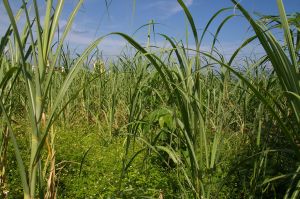Biofuels are considered a promising element in the renewable energies sector. Their production, however, is also associated with the emission of greenhouse gases. For the production of ethanol, a biofuel of the first generation, from sugar cane, a team of scientists headed by Professor Klaus Butterbach-Bahl from the Atmospheric Environmental Research Division of the KIT Institute of Meteorology and Climate Research (IMK-IFU) has identified the the sources of greenhouse gas emissions and formulated proposals for mitigation.
It was the objective of the environmental researchers to find out whether the climatic advantage of sugar cane-based ethanol is reduced, if emissions associated with the cultivation of sugar cane specifically of nitrous oxide (N2O) and changes in soil and vegetation carbon stocks due to land use change are considered as well. For this purpose, they evaluated data from Brazil and Australia. Now, the results have been published by the journal “Global Change Biology Bioenergy”: Factors like land use changes or fertilizers have the largest influence on total greenhouse gas emissions. According to the researchers, emission of nitrous oxide (N2O, “laughing gas”) produced by nitrogen fertilization in particular has been underestimated so far. Literature search reveals that the emissions are above the value of one percent for direct soil emission due to nitrogen fertilization recommended by the Intergovernmental Panel on Climate Change, IPPC. “The variety of production systems and the uncertainty with respect to the greenhouse balance of bioethanol based on sugar cane clearly demonstrate that further measurements are required to comprehensively evaluate environmental impacts,” says Klaus Butterbach-Bahl, Head of the Biogeochemical Processes Division of IMK-IFU.
To minimize greenhouse gas emissions in the future, the team recommends to improve the production process at all points. Currently, sugar cane fields are still burnt down in order to facilitate harvesting. Mechanical harvesting, however, might preserve or even increase carbon and nitrogen binding in the soil.
Bioethanol is considered a fuel of high potential. Biofuels of the second generation that are currently developed may further optimize climate compatibility. In contrast to fuels of the first generation that are based on cultural plants, they are based on residual biomass from agriculture and forestry. This makes their greenhouse gas balance more favorable. Moreover, their production does not compete with that of food.
Being “The Research University in the Helmholtz Association”, KIT creates and imparts knowledge for the society and the environment. It is the objective to make significant contributions to the global challenges in the fields of energy, mobility, and information. For this, about 10,000 employees cooperate in a broad range of disciplines in natural sciences, engineering sciences, economics, and the humanities and social sciences. KIT prepares its 22,800 students for responsible tasks in society, industry, and science by offering research-based study programs. Innovation efforts at KIT build a bridge between important scientific findings and their application for the benefit of society, economic prosperity, and the preservation of our natural basis of life. KIT is one of the German universities of excellence.

